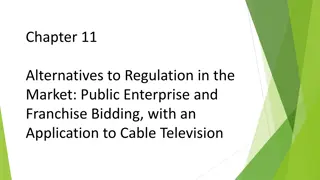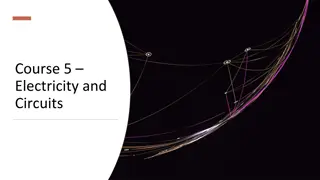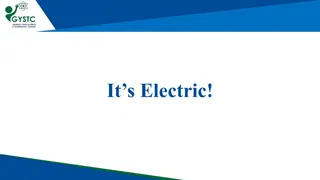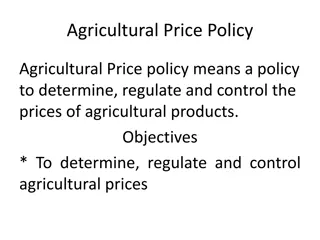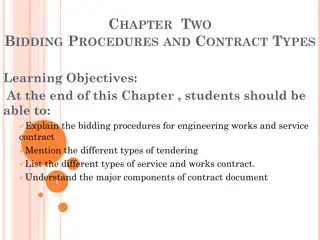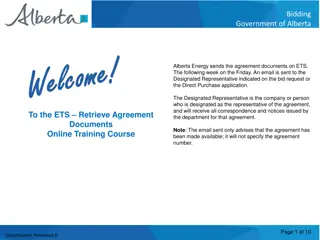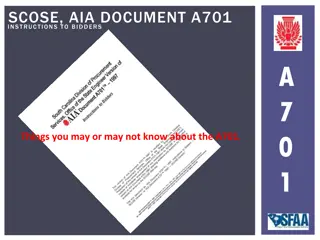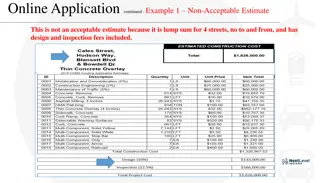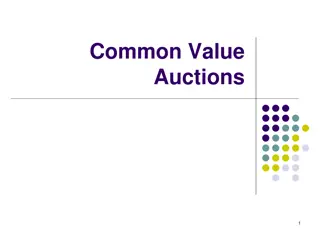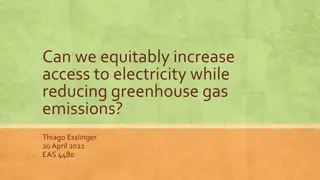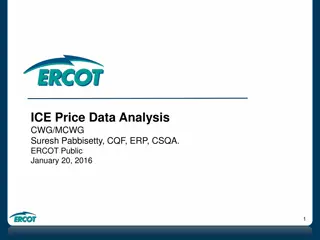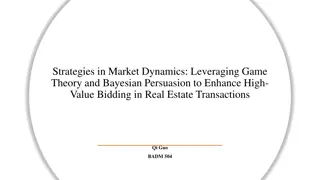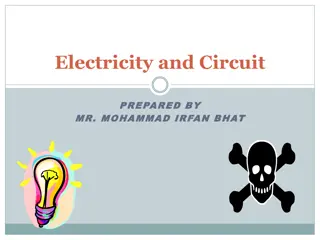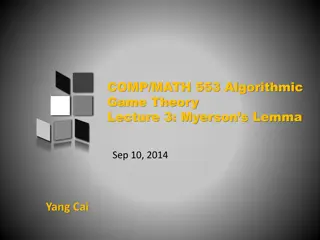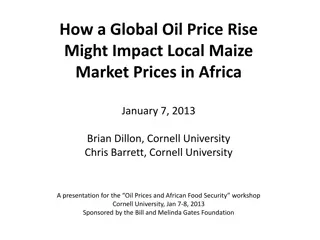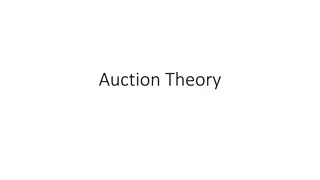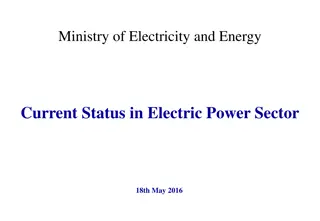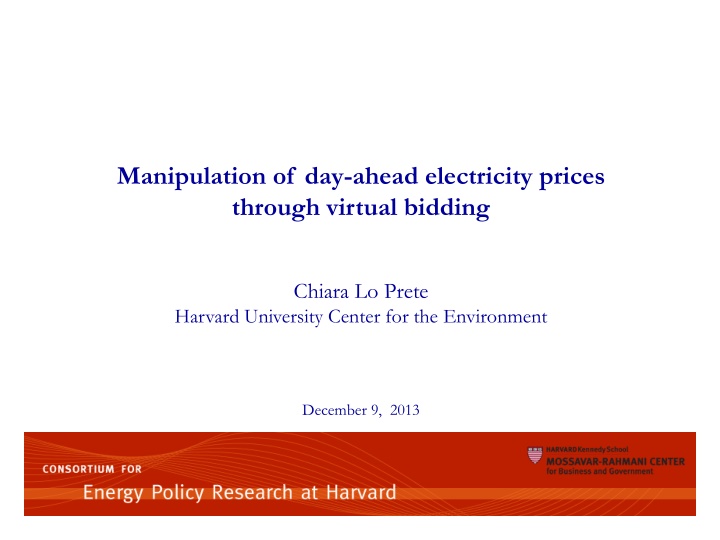
Manipulation of Electricity Prices Through Virtual Bidding
Discusses cases of market manipulation in the energy sector involving virtual bidding, civil penalties, and disgorgement, including examples from prominent companies like JP Morgan and Deutsche Bank. The violations settled by the Federal Energy Regulatory Commission are outlined, emphasizing the consequences and actions taken to prevent manipulation in energy markets.
Download Presentation

Please find below an Image/Link to download the presentation.
The content on the website is provided AS IS for your information and personal use only. It may not be sold, licensed, or shared on other websites without obtaining consent from the author. If you encounter any issues during the download, it is possible that the publisher has removed the file from their server.
You are allowed to download the files provided on this website for personal or commercial use, subject to the condition that they are used lawfully. All files are the property of their respective owners.
The content on the website is provided AS IS for your information and personal use only. It may not be sold, licensed, or shared on other websites without obtaining consent from the author.
E N D
Presentation Transcript
Manipulation of day-ahead electricity prices through virtual bidding Chiara Lo Prete Harvard University Center for the Environment December 9, 2013
FERC amps up market enforcement Types of violations settled by the Federal Energy Regulatory Commission, FY 2013 Market manipulation cases settled in FY 2013 Civil penalties ( 000 $) Disgorgement ( 000 $) Natural gas transportation OATT JP Morgan Ventures Energy Corporation 285,000 125,000 Enerwise 780 21 Reliability standards Market manipulation Market-based rate violations Hydro licensing Rumford Paper Company 10,000 2,836 Oceanside Power 51 29 Deutsche Bank Energy Trading 1,500 172 Gila River Power 2,500 911 Total 299,831 128,969 Civil penalties: 304 million $ Disgorgement: 141 million $ Source: U.S. Federal Energy Regulatory Commission, 2013 Report on Enforcement. 2
The Deutsche Bank case Summit Silver Peak intertie Sylmar DB violated the Commission s anti-manipulation rule through cross-product manipulation in which it traded physical exports at Silver Peak that were not profitable with the intent to benefit its CRR position. (FERC, 2013 Staff Report on Enforcement) 3
Other cases involving uneconomic trading to benefit financial positions Constellation Energy Commodities Group: settled in March 2012 (civil penalties: 135 million $, disgorgement: 110 million $) The effective date of this agreement shall be the later of the date on which: (a) the Commission issues an order approving this agreement without material modification; or (b) the merger pursuant to the agreement and plan of merger among Constellation Energy Group, Exelon Corporation and Bolt Acquisition Corporation is consummated. (Order approving stipulation and consent agreement, 138 FERC 61,168, Par. 44) Barclays Bank: currently being litigated In July 2013, FERC assessed civil penalties of 435 million $ against Barclays (plus disgorgement of 35 million $) The four traders face a combined 18 million $ in civil penalties 4
Manipulation of energy markets in the U.S. Federal statuses Three federal statutes prohibit manipulation of energy commodities in the U.S. Energy Policy Act of 2005 (EPAct) Energy Independence Security Act of 2007 (EISA) Commodity (CEA) Exchange Act and Provisions emphasize manipulation based on fraud and are patterned on Rule 10b-5 of the Securities and Exchange Commission (SEC) Provisions prohibit actions that create an artificial price* *An artificial price is defined as a price which does not reflect basic forces of supply and demand (Cargill vs. Hardin, Eighth Circuit, 1971). 5
Manipulation of energy markets in the U.S. Enforcement agencies Two agencies claim jurisdiction in most cases regarding manipulation of energy markets in the U.S. Federal Commission Energy Regulatory Commodity Futures Trading Commission (CFTC) Jurisdiction over wholesale sales and transmission of electric energy in interstate commerce; natural gas and oil pipeline transportation rates and services Jurisdiction over any swap, or contract of sale of any commodity, or contract for future delivery on or subject to the rules of any regulated exchange or trading facility CFTC s original anti-manipulation rule, modeled after Section 6(c) of the CEA, required proof of artificial price* FERC s modeled after SEC s Rule 10b-5, requires proof of the existence of a fraudulent intent anti-manipulation rule, *The CFTC s rule has been expanded with the addition of a provision that prohibits fraud-based manipulation after the passage of the Dodd-Frank Wall Street Reform and Consumer Protection Act in 2011 6
Manipulation of energy markets in the U.S. FERC s anti-manipulation rule (Title 18 C.F.R. 1c) It is unlawful for any entity, directly or indirectly, in connection with the purchase or sale of products subject to FERC jurisdiction, (1) To use or employ any device, scheme, or artifice to defraud*; (2) To make any untrue statement of a material fact or to omit to state a material fact necessary in order to make the statements made, in the light of the circumstances, not misleading; or (3) To engage in any act, practice, or course of business that operates or would operate as a fraud or deceit upon any entity. *FERC definesfraud as any action, transaction, or conspiracy for the purpose of impairing, obstructing or defeating a well-functioning market (Order No. 670, Par. 50). 7
Manipulation of energy markets in the U.S. Concerns and questions FERC s anti-manipulation rule is broadly framed and fraud-based Enforcement settlements contain little information what is FERC s framework for the analysis of market manipulation? How can energy traders affect electricity prices over a sustained period of time? 8
A possible framework for the analysis of day-ahead market manipulation through virtual bidding DAY-AHEAD (DA) MARKET CONDITION EQUILIBRIUM DISEQUILIBRIUM Example: Ledgerwood and Pfeifenberger, 2012 PRICE-SETTING PRICE-TAKING NO MANIPULATION NO RELATED FINANCIAL POSITIONS (Kyle, 1985) RELATED FINANCIAL POSITIONS UNECONOMIC DA POSITIONS ECONOMIC DA POSITIONS Remarks: No real-time market manipulation No collusion among market participants Choice of quantities, not supply/demand functions LEVERAGE > 1 LEVERAGE <= 1 NO MANIPULATION NO MANIPULATION MANIPULATION 9
Application of Kumar and Seppi (1992) 1 2 3 RT market FTR market Noise traders Uninformed trader DA market Noise traders Uninformed trader Informed trader Noise traders position e ~ N (0, 2e) u ~ N (0, 2u) Uninformed trader s position ~ N (0, 2W) z Informed trader s position x Aggregate position y1f = e + y2s = x+u+z Price v ~ N ( , 2v) S F The uninformed trader manipulates the DA price Manipulator s problem: Max Ee {Maxz Ev,u,x { [S(y1f, y2s) F(y1f)] + z[v-S(y1f, y2s)]|y1f}} s.t. | | |W| 10
Application of Kumar and Seppi (1992) There exists a unique equilibrium in which the manipulator: Randomizes its trading strategy in the FTR auction with equal probability (i.e., goes long |W| or short -|W| FTR positions at date 1), and then trades in the DA market Loses (on average) on its DA position Gains on its FTR position If the manipulator s FTR position ( ) is larger than its expected position on the DA market [E(z|e+ )], the overall manipulation strategy is profitable S = E(v) + [y2s E(y2s|y1f)] E(S) = E(v) 11
Types of equilibrium manipulation MANIPULATION OF DA PRICES E(S) = E(v) AND E(v-S)2 is higher E(S) E(v) [relative to the case in which there is no manipulator and E(S) = E(v)] (e.g., Kumar and Seppi, 1992) Randomized trading strategies on the FTR market CREDIBLE? Corr( , S) > 0 Empirical implications Price differential bounded by entry costs 12

